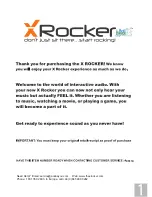
continued from preceding page
Turn the tow bar arm over and move the inner arm for-
ward or backward slightly, if necessary, until the button stem
drops through the hole in the outer arm. Then, draw a straight
line with a pencil across the bottom of the inner arm (Figure
4), 3/4" from the edge of the outer arm.
Slowly close the inner arm until the edge of the outer
arm is even with the pencil line you drew. This position will
stabilize and support the button stem.
Turn the tow bar arm back over and attach the Autowlok
button to the button stem, following steps 6 through 8 under
“To replace an Autowlok button…” on page three.
After the button has been attached, slide the inner arm
out of the outer arm.
5.
Remove the old inner front bushing (Figure 3). Apply a
light coat of lubricant to the inside of the new inner front
bushing. Use a dry silicone aerosol, such as LubeMaster
(part number 747).
CAUTION
Do not use petroleum-based products to lubricate
the tow bar. Petroleum will attract dirt and dust, which
will impede the operation of the inner arms and/or other
components. Certain petroleum products may also cor-
rode non-metallic components.
With the gap in the new inner front bushing facing down
(Figure 3), slide the bushing into position (Figure 3) on
the inner arm.
Test the fit — insert the inner arm into the outer arm and
slide the inner arm forward and backward, to its fullest
extent.
If the inner arm does not slide smoothly, or if the new
bushing is too wide to fit, use a grinder to trim a small
amount from the edges touching the inside of the outer
arm. Trim an equal amount from each side, test-fit the
inner arm and trim more, if necessary, until the inner arm
slides forward and backward easily.
6.
Remove the old rear bushing (Figure 3).
7.
Insert one of the new springs (Figure 2) into the open-
ing near the
inner front bushing
.
8.
Lubricate the bottom of one of the new pins (Figure 2)
thoroughly. As before, use a dry silicone aerosol. Then,
position the new pin, rounded side up (Figure 5), on the
new spring.
9.
Hold the pin down flush to the top of the inner arm,
and insert the inner arm into the outer arm. Slide the arm
forward until the Autowlok button snaps into the locked
position (Figure 6).
10.
Apply a light coat of lubricant to the inside of the new
rear bushing. As before, use a dry silicone aerosol. Then,
with the gap in the bushing facing down (Figure 3), slide
the new rear bushing onto the inner arm and forward, until
the edge of the bushing is flush to the edge of the outer
arm, as shown in Figure 6.
If the new bushing is too wide to fit into the outer arm,
use a grinder to trim a small amount from the edges
Figure 4
Figure 5
Figure 6
ing the inside of the outer arm. Trim an equal amount from
each side, test-fit the bushing and trim more, if necessary,
until the bushing fits.
11.
With the Autowlok button in the locked position, reat-
tach the 3/8" safety bolt and nut you removed in step 1.
WARNING
Ensure that the arm is locked before replacing the
3/8" safety bolt and nut. Unless the arm is locked
before the bolt and nut are replaced, the Autowlok
mechanism will not function — the tow bar arm will
not lock





















